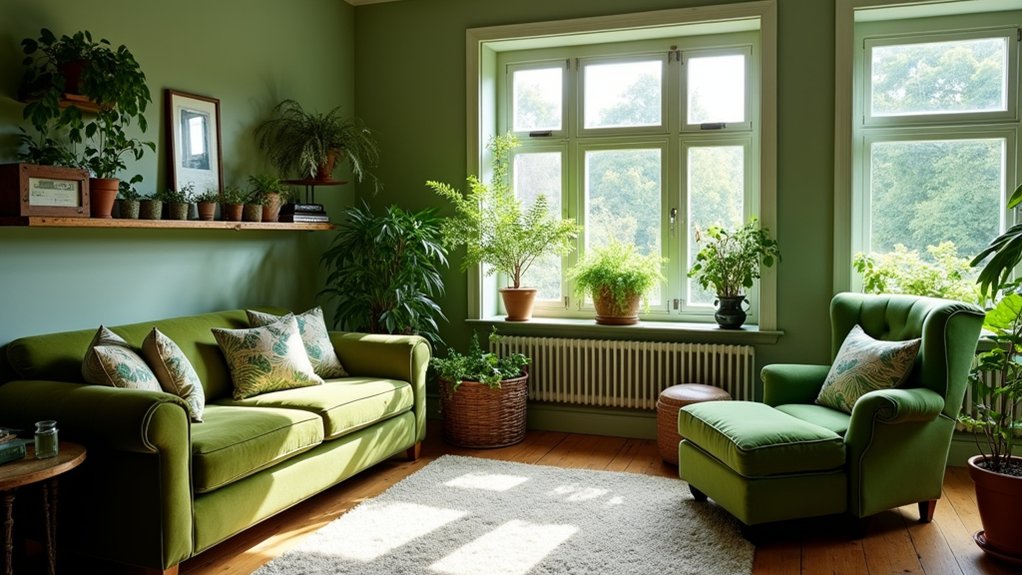
22 Green Living Room Ideas That Are Fresh, Natural, and Inviting
Green living room ideas center on lush indoor plants, harmonious color palettes, and layered textures for a contemporary organic atmosphere. Deep green feature walls pair well with warm neutrals, while plush velvet sofas serve as sophisticated focal points. Contrasting gold, wood, or black-and-white accents add definition and warmth. Ample natural light and clever use of mirrors amplify the space’s vibrancy. Integrating patterned textiles and retro elements guarantees lively, inviting interiors—discover even more inspiring approaches just ahead.
Key Takeaways
- Incorporate resilient indoor plants like snake plants and pothos to amplify natural aesthetics and purify the air.
- Paint a bold green feature wall or use botanical wallpaper for a dramatic, nature-inspired focal point.
- Anchor the room with a green velvet sofa, layering with neutral and green throw pillows for comfort and style.
- Pair green walls with warm neutrals and light wood tones to create a balanced, inviting atmosphere.
- Enhance the space with mixed textures—plush rugs, velvet cushions, and natural materials—for depth and cozy sophistication.
Embrace Nature With Indoor Plants
By integrating indoor plants into a living room, designers can enhance both visual appeal and environmental quality, reinforcing the green theme with natural textures and hues.
Introducing a diverse assortment of indoor plants—such as snake plants, pothos, and peace lilies—enriches the green living room with layered foliage while supporting a calming atmosphere. These species are renowned for their resilience and minimal maintenance requirements, making them ideal for a range of lighting conditions.
A mix of resilient indoor plants like snake plants and pothos brings calming, lush layers to any green living room.
Strategically placing plants of varying heights and leaf structures creates a visually compelling arrangement, filling negative space and providing organic contrast to furnishings. For spatial efficiency, hanging planters or wall-mounted displays act as living art, especially in compact rooms.
Ultimately, this botanical integration supports relaxation, air purification, and a cohesive, nature-inspired design narrative. A well-chosen plant like Begonia Maculata not only adds striking visual appeal with its polka-dotted leaves but also thrives in well-draining soil, making it a stylish and practical choice for enhancing living room decor.
Pair Green Walls With Warm Neutrals
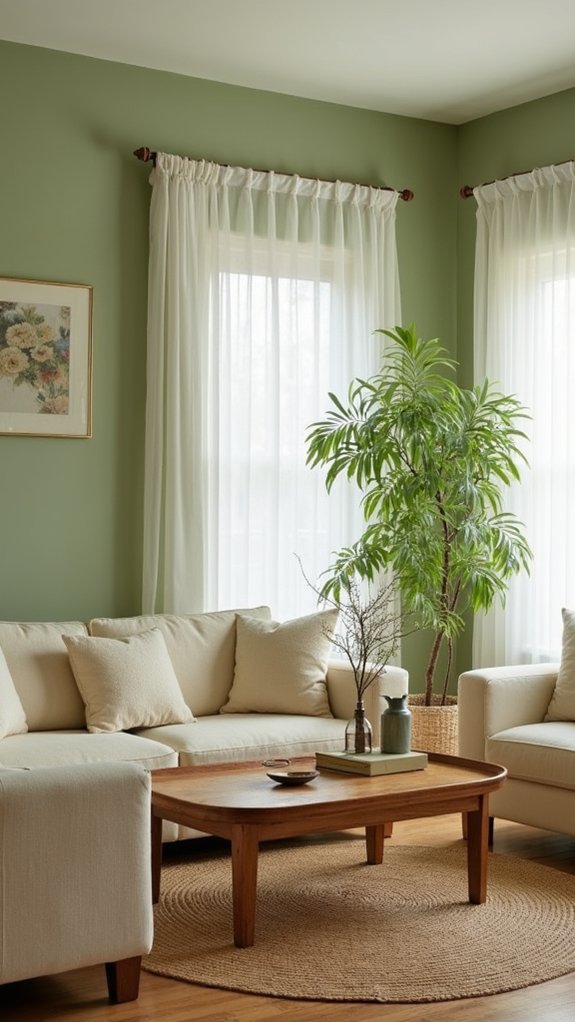
To further enhance a nature-inspired living room, pairing green walls with warm neutrals introduces a sophisticated balance between vibrancy and comfort.
Green walls establish a rejuvenating backdrop, while warm neutrals—such as beige, cream, or light taupe—mitigate intensity and infuse the space with inviting warmth.
Light wood tones like oak or maple visually anchor the palette, echoing organic elements and enriching the room’s textural depth.
Integrating earthy tones such as terracotta or warm browns through accent pieces or textiles strengthens the natural aesthetic and fosters a serene, grounded ambiance.
Opting for warm neutral furnishings—think a cream sofa or rattan chairs—allows the green walls to serve as a bold yet harmonious statement.
This approach results in a cohesive, balanced, and visually appealing living room.
Create Drama With a Dark Green Feature Wall
Introduce bold sophistication into a living room with a dark green feature wall, instantly anchoring the space and establishing a dramatic focal point. Utilizing deep shades of green, such as Blue Jade by Valspar or Studio Green, enhances visual interest and enhances architectural elements. This approach works exceptionally well in low-light rooms, where a dark green feature wall fosters a cozy atmosphere without overwhelming the space if balanced with light accents and reflective surfaces. To maximize the impact and maintain a harmonious aesthetic, consider these expert strategies: Select rich, saturated shades of green for depth and visual intrigue. Pair with light-toned furnishings or metallic accents to prevent heaviness. Introduce mirrors to reflect natural light and expand the sense of space. Integrate pink or gold decor for added warmth and elegance. Layer textures to enrich the overall ambiance. Incorporate strategic use of black accessories to ensure cohesion and elegance in the design.
Choose a Green Velvet Sofa as a Focal Point
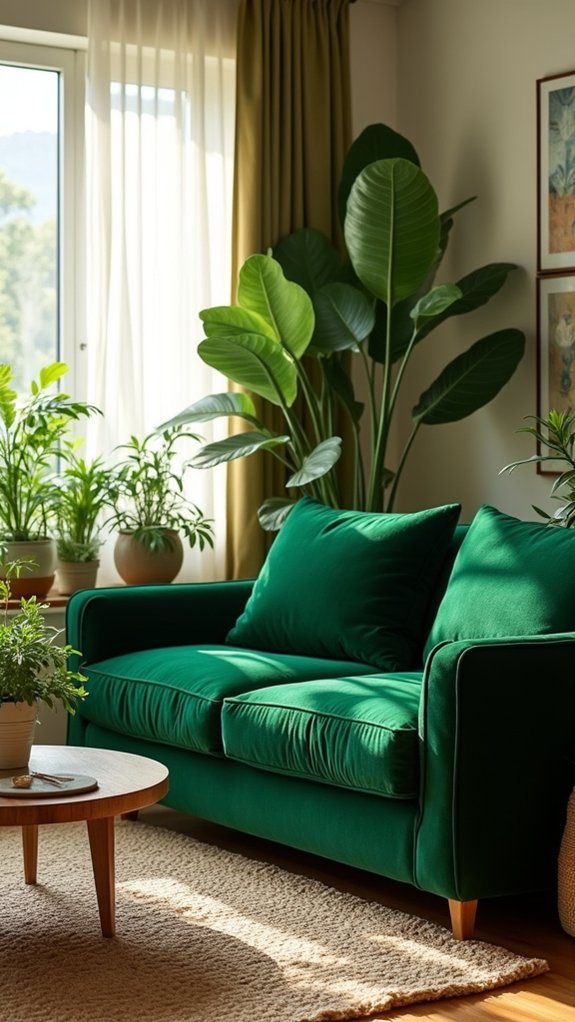
A green velvet sofa commands attention as a powerful design anchor, instantly elevating the visual hierarchy of any living room. The tactile allure of velvet, paired with the organic richness of green, creates a focal point that embodies both sophistication and natural beauty.
This piece seamlessly bridges modern and traditional aesthetics, offering versatility in styling. To maximize impact, designers recommend pairing the green velvet sofa with gold accents or wooden elements, which add warmth and depth.
Layering with throw pillows and blankets in various green hues and neutral tones further softens the look, maintaining the fresh, inviting character of the space.
Ultimately, the green velvet sofa not only guarantees comfort but also establishes an artful statement, drawing the eye and fostering conversation.
Balance Green With Black and White Accents
When black and white accents are strategically layered into a green living room, the resulting contrast sharpens the vibrancy of green while ensuring visual balance across the space. This sophisticated interplay between black and white elements and green accents enhances the aesthetic, introducing clarity and structure. A crisp white foundation—be it walls or core furnishings—amplifies the luminosity of mid-green shades, while sleek black details inject depth and a modern edge. The integration of neutral tones maintains cohesion and versatility, allowing warm natural materials to soften the overall scheme. Incorporating metallic accents such as gold or copper can complement the black and white palette, adding glamour and sophistication to the living room. For maximum impact and practicality, consider the following:
- White walls to maximize light and highlight green accents
- Black-framed artwork for contemporary definition
- Patterned black and white textiles for visual interest
- Neutral-toned furniture for cohesive layering
- Sleek black light fixtures for refined contrast
Use Botanical Prints for a Fresh Touch
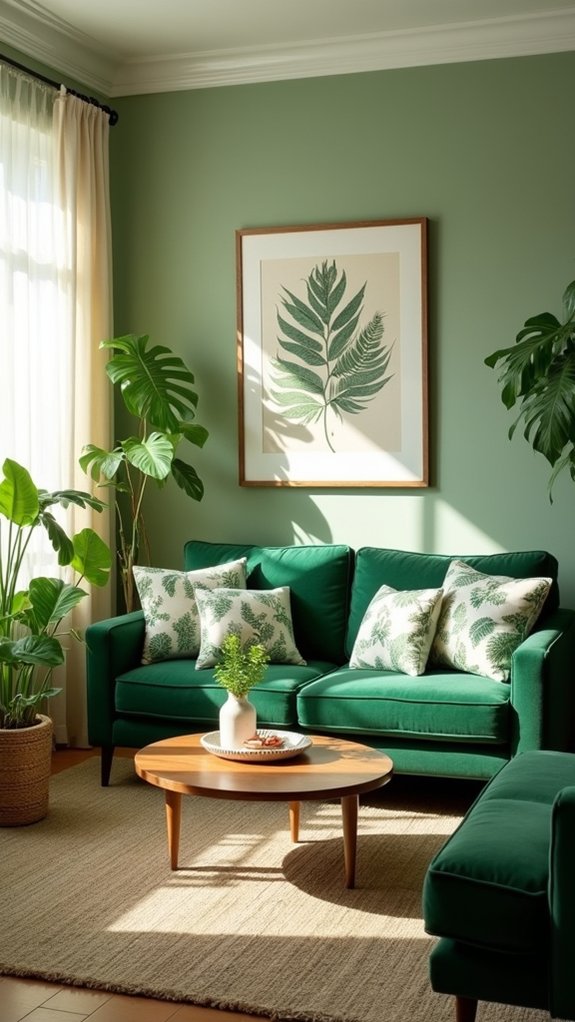
While many design elements can invigorate a green living room, botanical prints stand out for their ability to reinforce the space’s connection to nature. Botanical prints, whether featured in wallpaper or soft furnishings, introduce a vibrant and rejuvenating visual element, supporting a cohesive natural aesthetic in green living rooms.
Soft green botanical wallpaper with delicate floral designs fosters tranquility while infusing subtle charm. Expertly layering botanical motifs with earthy textures—such as rattan furniture or light wooden floors—amplifies the organic ambiance.
For those seeking a balanced approach, integrating botanical prints through cushions, artwork, or smaller accessories avoids visual clutter while maintaining unity. Combining trailing plants like Pothos with botanical prints further enhances the sense of freshness, creating a curated living environment that feels both invigorating and harmonious.
Add Warmth With Wood Tones
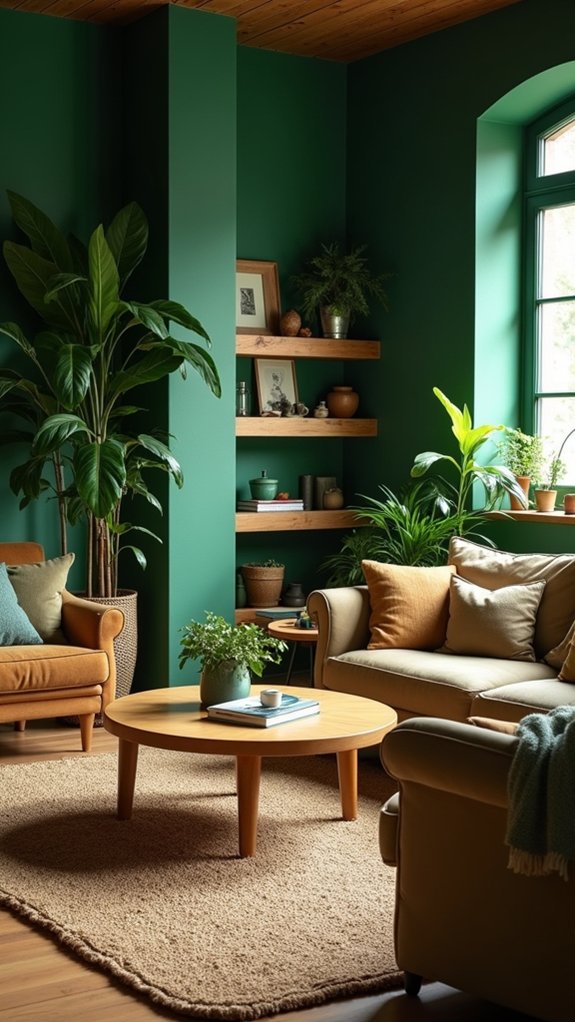
Pairing green with oak introduces a subtle luminosity that enhances the room’s palette, while simultaneously reinforcing a sense of comfort. Incorporating rustic wood textures—such as reclaimed beams or rough-hewn tables—brings tactile richness and visual complexity to the environment. For ideal cohesion, designers recommend balancing these elements to achieve a harmonious interplay between organic warmth and verdant tones. Integrating natural materials like wood and stone creates a rustic, warm ambiance that complements the green hues beautifully.
Pair Green With Oak
Although green serves as a versatile foundation for living room palettes, integrating oak wood tones introduces essential warmth and visual balance.
Oak’s subtle grain and soft, neutral coloring naturally complement green hues, fostering a serene atmosphere that feels both inviting and grounded.
By thoughtfully pairing oak furniture with varying shades of green, designers achieve a harmonious, organic aesthetic without visual overload.
This strategy leverages oak’s adaptability, enabling seamless coordination with everything from pale sage to deep forest green.
Key considerations for combining green and oak include:
- Select oak coffee tables or shelving to add tactile depth.
- Layer green hues on walls or textiles for cohesive contrast.
- Opt for matte finishes to enhance oak’s natural texture.
- Use oak accents to frame green focal points.
- Maintain open layouts to highlight material interplay.
Embrace Rustic Textures
To cultivate a sense of warmth and organic depth within a green living room, designers often recommend embracing rustic textures through the strategic use of wood tones.
Integrating natural wood—such as furniture, beams, or paneling—introduces tactile variation that harmonizes with green hues, enhancing the room’s visual interest. Reclaimed or distressed wood finishes add character and authenticity, establishing a grounded, inviting atmosphere.
Light wood tones paired with green paints or soft furnishings can create a serene, luminous environment while preserving rustic charm. Incorporating ample wood tones not only balances the coolness of green but also forges a seamless connection between indoor and outdoor spaces.
Employing natural wood elements, both structural and decorative, guarantees the living room remains cohesive, welcoming, and visually layered.
Experiment With Green Wall Panelling
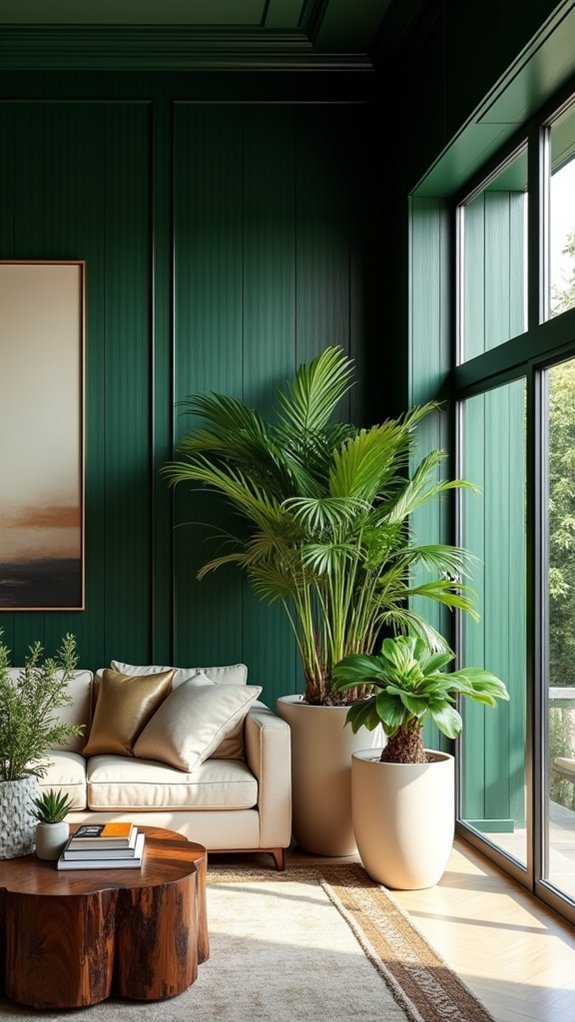
Introducing green wall panelling instantly adds texture and depth to a living room, establishing a sophisticated and contemporary foundation. This design approach leverages both tactile and visual interest, making the space feel more curated and architecturally engaging.
Green wall panelling offers a spectrum of shades of green, enabling homeowners to add depth and interest while maintaining a cohesive palette. Panel effect wallpaper is a practical alternative, replicating the elegance of wood without the installation demands.
To maximize the effect, consider these expert strategies:
- Utilize panel effect wallpaper for easy installation and visual impact
- Pair green wall panelling with light wood accents for warmth
- Select varying shades of green to create layered dimension
- Integrate gold fixtures or botanical motifs for contrast
- Use panelling as a backdrop to highlight curated art or décor
Mix and Match Different Shades of Green
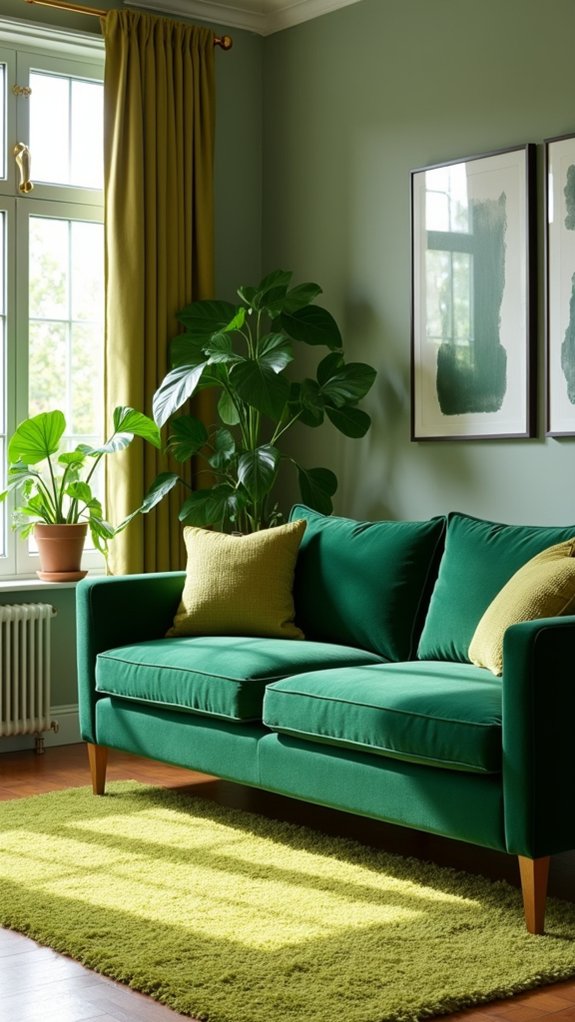
Building on the architectural impact of green wall panelling, layering multiple shades of green enhances the living room’s visual narrative.
Expertly mixing green shades—such as juxtaposing bold emerald sofas with soft sage wallpaper—creates harmonious contrast while retaining cohesion. Layering greens, like olive accents paired with pistachio cushions, introduces depth and textural richness, reinforcing the room’s character.
Employing a spectrum of green paints, from moody forest to moss, infuses dynamic energy and optimizes comfort. Textural elements, including plush rugs or knitted throws in various green tones, further amplify visual interest and tactile comfort.
Incorporating indoor plants like ferns and succulents amplifies organic aesthetics, seamlessly blending with the layered green hues.
This nuanced approach to mixing green shades cultivates a vibrant yet tranquil environment, evoking a strong connection to nature and supporting restorative relaxation within the living space.
Incorporate Pastel Greens for a Light Atmosphere
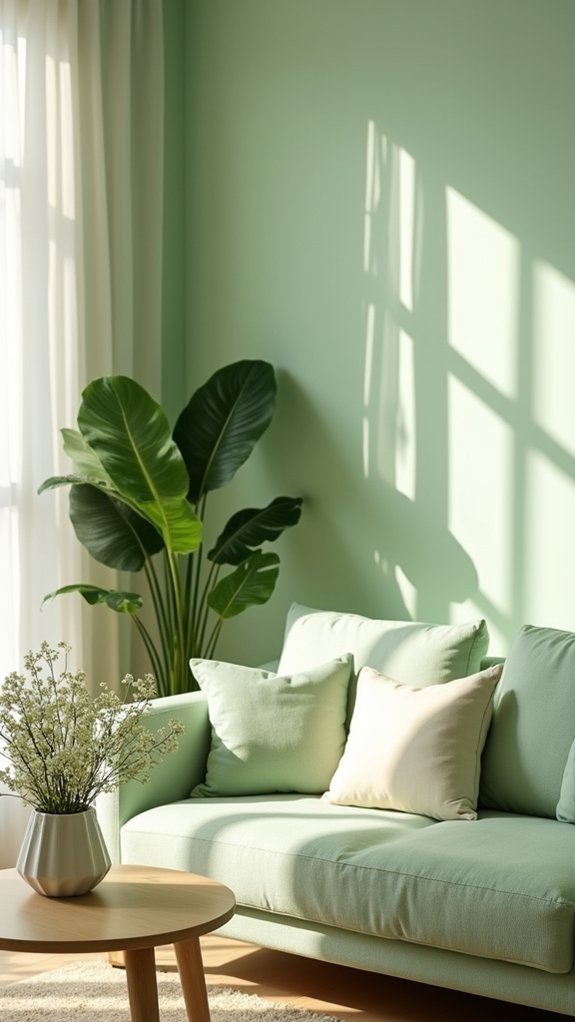
When pastel greens such as sage or mint are incorporated into a living room palette, the result is a serene, light-filled environment that fosters relaxation and spaciousness. These gentle hues introduce a sense of tranquility and modernity, making them ideal for spaces where natural light is maximized. Expert designers recommend balancing pastel greens with neutral furnishings and light wood tones to preserve an airy ambiance. Integrating botanical prints and indoor plants further reinforces a fresh, organic aesthetic. Consider these practical strategies:
- Pair pastel green walls with ivory or beige sofas for contrast
- Use mint or sage cushions and throws for subtle color accents
- Select light wood coffee tables to enhance brightness
- Incorporate botanical prints through artwork or textiles
- Place potted plants to echo the natural color palette
Layering textures like linen and faux fur can add depth and comfort to the space, ensuring a cohesive design aesthetic through thoughtful textural contrasts.
Make a Statement With Green Stripes
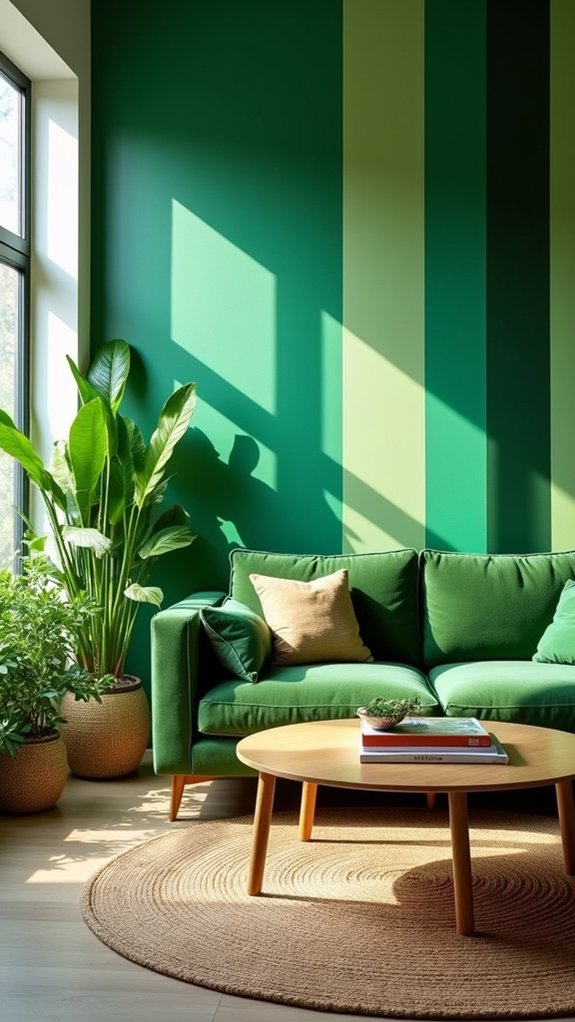
Beyond the gentle appeal of pastel greens, green stripes present a dynamic alternative for those seeking visual impact in the living room. Applying green stripes with paint or wallpaper can make a bold statement, infusing energy and structure into the space. Using masking tape guarantees crisp, professional-grade lines, allowing for versatile stripe orientations—vertical, horizontal, or even diagonal. Stripe width can be tailored, ranging from subtle pinstripes to dramatic wide bands, catering to both minimalist and maximalist aesthetics. This technique is accessible and budget-friendly, ideal for both renters and homeowners. To achieve a cohesive design, pair green stripes with neutral furnishings and vibrant accessories. The table below outlines practical aspects:
| Stripe Type | Application Method | Design Impact |
|---|---|---|
| Pinstripe | Paint/Tape | Subtle, Refined |
| Wide Bands | Paint/Tape | Make a Bold, Modern |
| Diagonal | Wallpaper | Dynamic, Playful |
Add Depth With Contrasting Colours
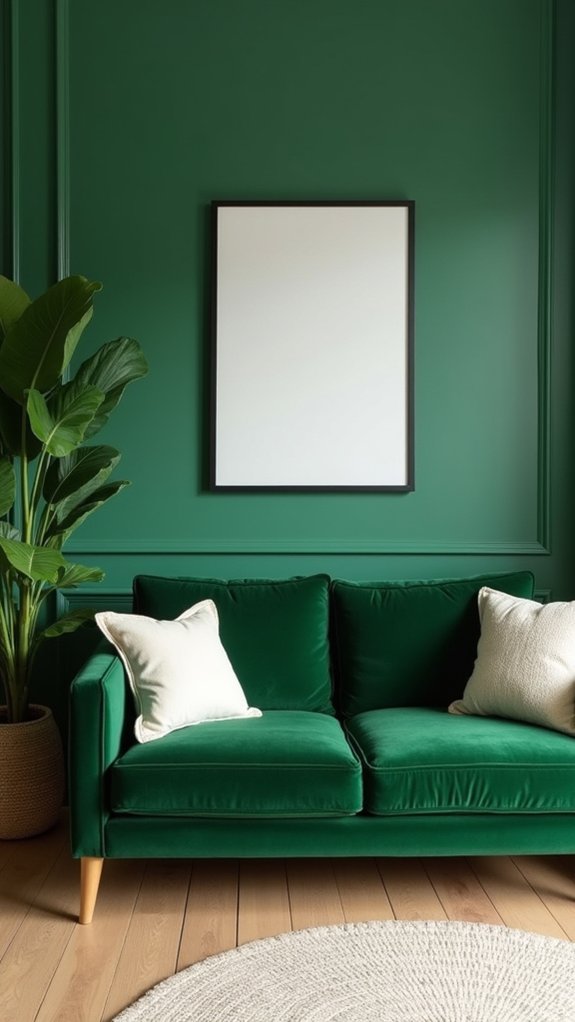
Combining green with contrasting hues such as blush pink, bold black and white, or warm orange infuses a living room with dynamic visual layering. Strategic placement of these colors—through upholstery, accent walls, or décor objects—amplifies depth and defines architectural elements. This approach guarantees a balanced scheme where green acts as a versatile anchor amid vibrant focal points. Incorporating houseplants to balance green tones not only adds a natural touch but enhances the overall aesthetic appeal by providing a seamless link between the indoors and nature.
Pair Green With Pink
Although green is often celebrated for its calming effect, introducing shades of pink as a contrasting accent can transform a living room with vibrant depth and visual intrigue.
The interplay between a rich green hue and soft pink accents achieves a sophisticated balance, enhancing both warmth and dynamism. To cultivate a natural vibe while maintaining visual complexity, designers recommend strategic color layering and motif selection.
Consider these key approaches:
- Combine deep green walls with blush or fuchsia cushions for a tailored color story.
- Incorporate botanical prints in green alongside pink accessories to reinforce organic themes.
- Use soft pink throws or rugs to soften bold green furniture, promoting comfort.
- Layer various pink shades against green for subtle gradation.
- Select artwork that integrates both colors for a curated, cohesive look.
Bold Black and White
Strategic use of black and white introduces a bold graphic element to green living rooms, establishing an enhanced sense of depth and sophistication.
In a dark green living room, crisp white trims or a dedicated accent wall in matte black can offer striking contrast, amplifying the vibrancy of pops of green throughout the space.
Mid-green tones, when juxtaposed with monochrome accessories—such as patterned cushions, sculptural vases, or black-and-white artwork—create a layered and visually dynamic effect.
This interplay between dark and light not only heightens spatial drama but also delivers versatility, allowing for effortless updates as green shades or decorative patterns evolve.
For maximum impact, designers recommend a balanced distribution of black and white elements to guarantee green remains the focal point and the room feels cohesive.
Accentuate With Warm Orange
A vibrant splash of warm orange can invigorate a green living room, introducing depth through dynamic contrast. Expertly applied, this technique leverages colour theory by setting warm orange accents against mid-green or sage walls, producing a visually engaging interplay.
The result is a balanced, inviting atmosphere that feels both fresh and rooted in a natural touch. Designers recommend integrating orange through select accessories to avoid overwhelming the space while maximizing impact.
Consider these practical green living room ideas:
- Layer orange cushions or throws on a forest green sofa for instant vibrancy.
- Hang orange-hued artwork to create a striking focal point.
- Use terracotta ceramics to reinforce the earthy palette.
- Introduce patterned rugs combining green and orange for cohesive warmth.
- Select botanical prints featuring orange blooms for subtle continuity.
Use Green in a Bold Work-from-Home Corner
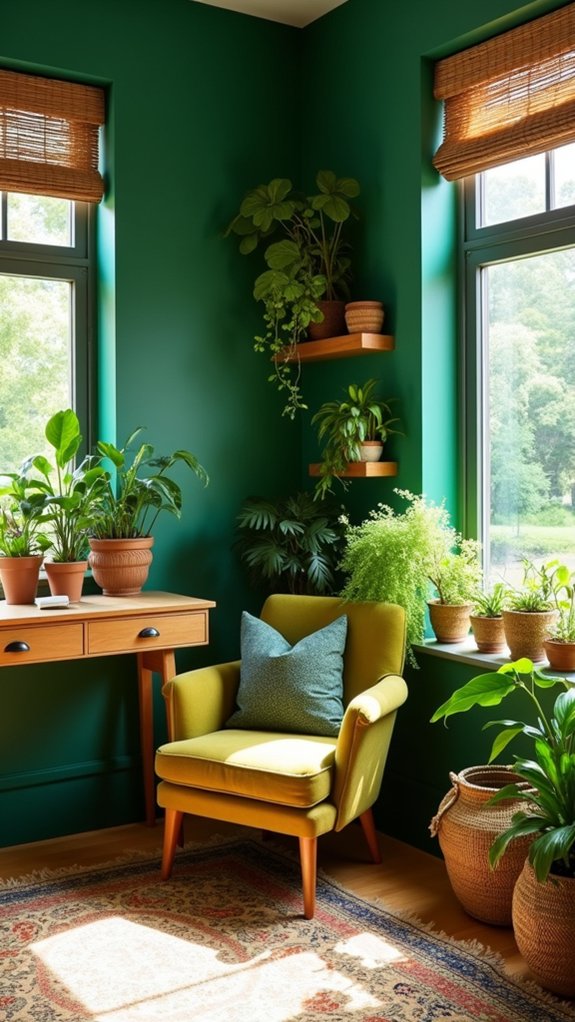
Many home offices benefit from the invigorating impact of deep forest green, which fosters both creativity and tranquility in a multitasking environment.
Introducing a dark green feature wall in the work from home corner establishes a visually commanding backdrop that distinguishes the workspace from the broader living area.
Expert designers recommend pairing bold green hues with comfortable seating, such as a plush green velvet chair, to enhance ergonomic support and visual cohesion.
Strategically positioning the desk to maximize views of the outdoors seamlessly integrates natural light and scenery, thereby elevating mental well-being.
Layering varying shades—from soft sage to rich emerald—serves to add depth and visual complexity, making the workspace feel dynamic.
Accents like potted plants or green artwork further personalize and invigorate the area.
Highlight Green With Brass and Metallic Accents
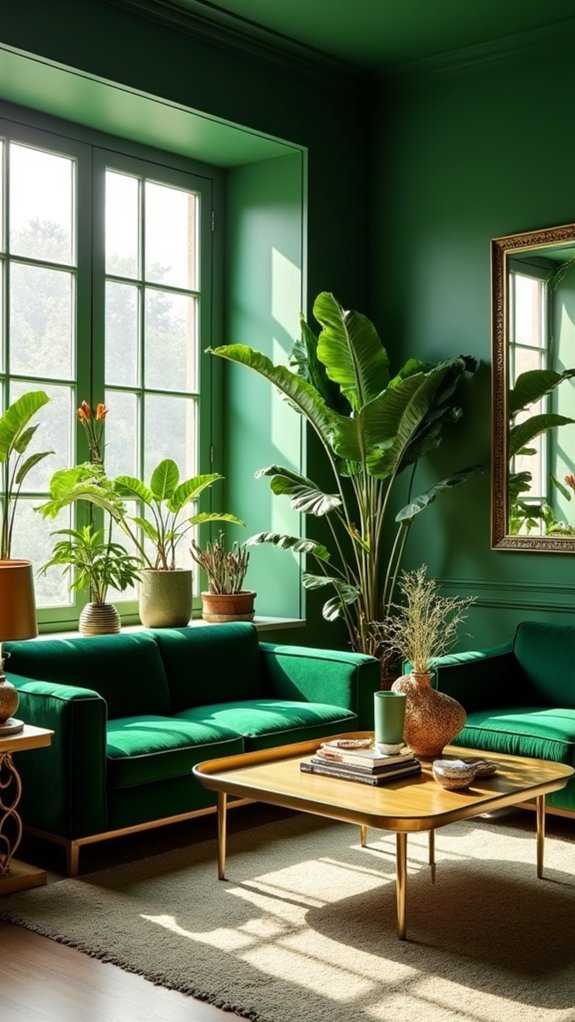
How can one enhance the visual impact of a green living room?
Integrating brass and metallic accents with green tones establishes a sense of luxury and visual intrigue. The interplay of metallic elements with green walls or upholstery brings both warmth and sophistication, elevating the room’s aesthetic.
Reflective surfaces such as brass amplify ambient and natural light, ensuring the space feels open and inviting. To achieve a balanced, modern ambiance, designers recommend strategic placement of metallics for maximum effect.
Consider the following practical applications:
- Position brass-framed mirrors to reflect light and expand spatial perception.
- Incorporate gold or metallic light fixtures for a luminous focal point.
- Select brass hardware or handles for cabinetry in green settings.
- Introduce metallic vases or sculptures for artistic contrast.
- Use metallic accent tables to ground rich green tones.
Try a Scandi-Inspired Green Living Room
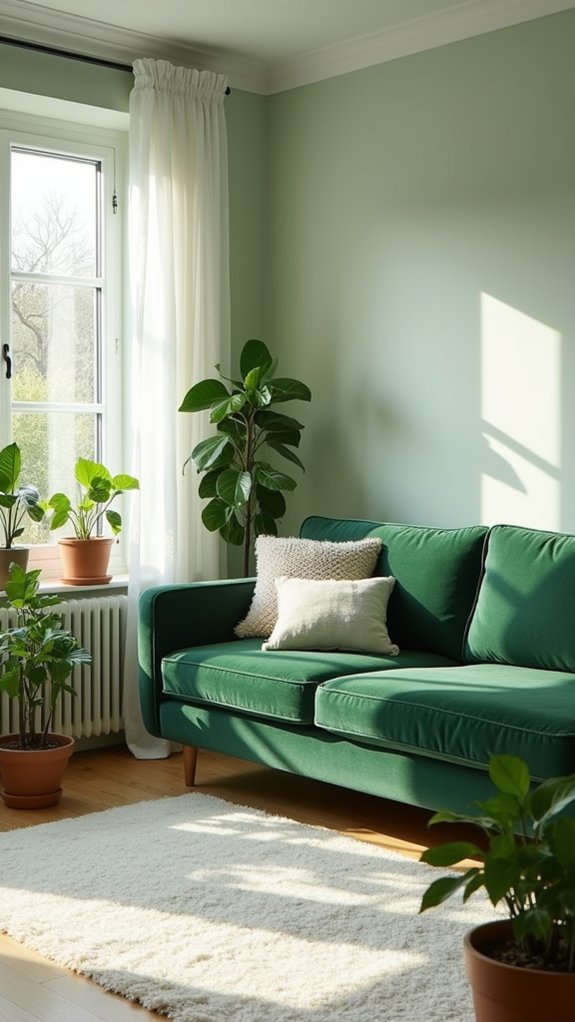
Blending the serene tones of green with the clean lines and natural textures of Scandinavian design cultivates a space that feels both invigorating and tranquil. In a Scandi-inspired green living room, lightweight furniture guarantees an airy, modern aesthetic, optimizing natural light and spatial flow. Harmonizing biscuit and cream hues with green elements delivers a balanced, calming palette—ideal for relaxation or lively living. Oversized plants are employed as visual anchors, reinforcing the biophilic connection and softening minimalist lines. Low-profile sofas contribute to an open, inviting layout, while textured fabrics and natural materials, such as wool throws or rattan, enhance coziness without overwhelming the minimalist ethos.
| Element | Function | Visual Impact |
|---|---|---|
| Green Accents | Calming Palette | Serene, Fresh |
| Natural Light | Spatial Brightness | Airy, Open |
| Textured Fabrics | Tactile Warmth | Cozy, Layered |
Refresh the Space With Sage Green Details
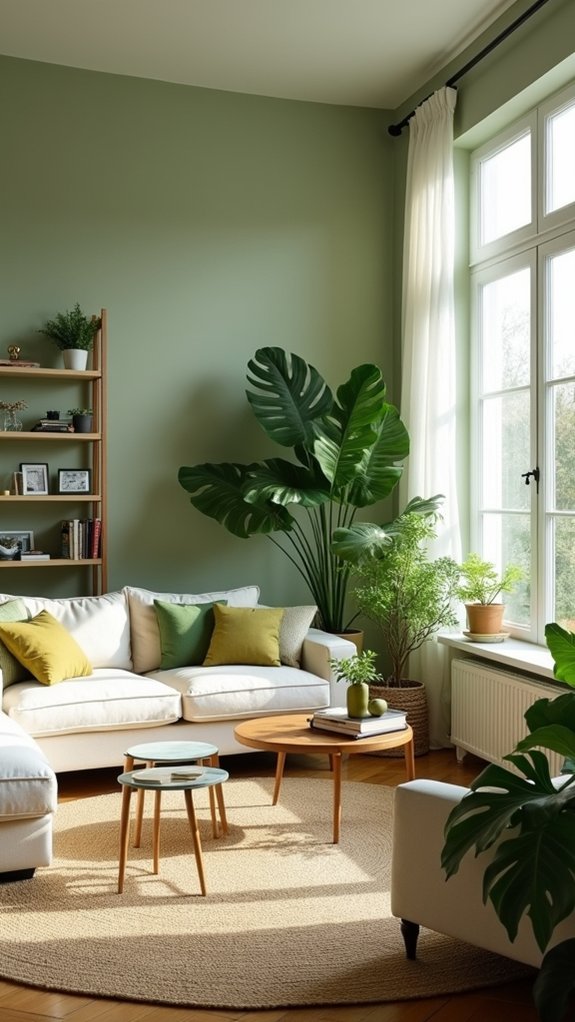
Introducing sage green through accent walls, soft furnishings, and subtle decor accents establishes a tranquil foundation for contemporary living rooms. Expertly coordinated cushions, throws, and decorative objects in this muted hue offer both visual harmony and textural interest. For maximum impact, pairing sage elements with natural materials and gentle neutrals guarantees a balanced, rejuvenating atmosphere. Warm greens like sage and forest green enhance coziness and connect to nature, creating an ambiance that whispers relaxation and warmth.
Accent Walls in Sage
While many color palettes can refresh a living room, opting for a sage green accent wall instantly establishes a soothing and contemporary foundation.
This subtle yet sophisticated hue enhances inviting decor by promoting relaxation and seamlessly blending with a wide array of design styles. Sage green accent walls serve as a versatile canvas, reflecting natural light and harmonizing with both vibrant and neutral color schemes.
Designers frequently employ this hue to create depth and visual balance while maintaining a light, airy ambience.
- Enhances spatial perception by maximizing the effect of natural daylight.
- Complements warm oranges, pinks, and neutrals for a cohesive palette.
- Functions as a dynamic backdrop for striking artwork or sculptural décor.
- Integrates effortlessly with modern, rustic, or adaptable furniture styles.
- Achieves visual interest through wall panelling or painted architectural details.
Sage Green Soft Furnishings
Soft furnishings in sage green offer a strategic approach to revitalizing a living room’s aesthetic, infusing the space with tranquility and subtle color. Selecting sage green cushions, throws, and curtains introduces a calming palette that harmonizes with both neutral tones and organic materials. The versatility of sage green allows it to blend seamlessly with modern, rustic, or minimalist interiors, enhancing the ambiance with a natural touch. Sage green upholstery on sofas or accent chairs serves as a sophisticated focal point, while textured fabrics—such as velvet or linen—add depth and tactile interest. Consider the following options for integrating sage green soft furnishings:
| Item Type | Material | Visual Impact |
|---|---|---|
| Cushions | Velvet | Plush, inviting texture |
| Throws | Linen | Light, relaxed layering |
| Curtains | Cotton blend | Soft, airy light diffusion |
| Upholstery | Chenille | Subtle, refined elegance |
| Poufs/Ottomans | Woven fabric | Earthy, grounding accent |
Subtle Sage Decor Accents
Delicate accents in sage green provide an understated yet effective method for revitalizing a living room’s decor. This muted hue introduces tranquility, seamlessly complementing both contemporary and traditional interiors.
Employing sage green in measured doses maximizes its visual impact without overwhelming the space. Expert designers often recommend integrating this tone through strategic decor elements that harmonize with natural wood elements and light textiles.
For those seeking practical ways to infuse serenity and sophistication, consider the following applications:
- Incorporate sage green throw pillows or blankets for an instant refresh
- Apply sage green wall accents, such as painted trim or botanical wallpaper
- Display ceramic vases or planters in this calming shade
- Pair sage green accessories with natural wood elements for organic contrast
- Layer sage green textiles with neutral or pastel furnishings
Layer Textures With Cushions and Throws
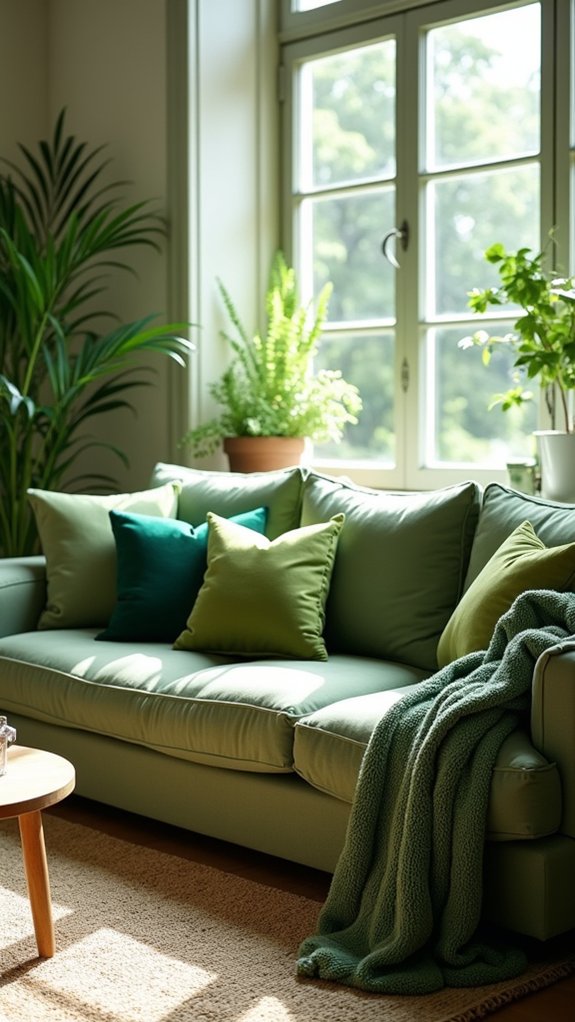
Enhancing a green living room’s visual depth and comfort, layering cushions and throws introduces an array of tactile and chromatic elements.
Expertly curated textures—such as knitted, velvet, or cotton cushions—establish a sophisticated interplay of surfaces that invigorate a green palette.
Employing cushions in multiple shades of green, along with select accents like mustard or burnt orange, generates harmonious contrast and visual intrigue.
A mix of green cushions with mustard or burnt orange accents creates harmonious contrast and elevates the room’s visual interest.
Throws, artfully draped over sofas or armchairs, not only provide warmth but also serve as versatile color and pattern anchors within the space.
Opting for cushions and throws in assorted sizes and shapes encourages a relaxed, lived-in ambiance.
This strategic use of soft furnishings allows for effortless seasonal updates while maintaining a cohesive, inviting aesthetic in any green living room.
Incorporating plush fabrics like velvet not only enhances comfort but also adds a luxurious feel to the space.
Combine Green With Patterned Decor
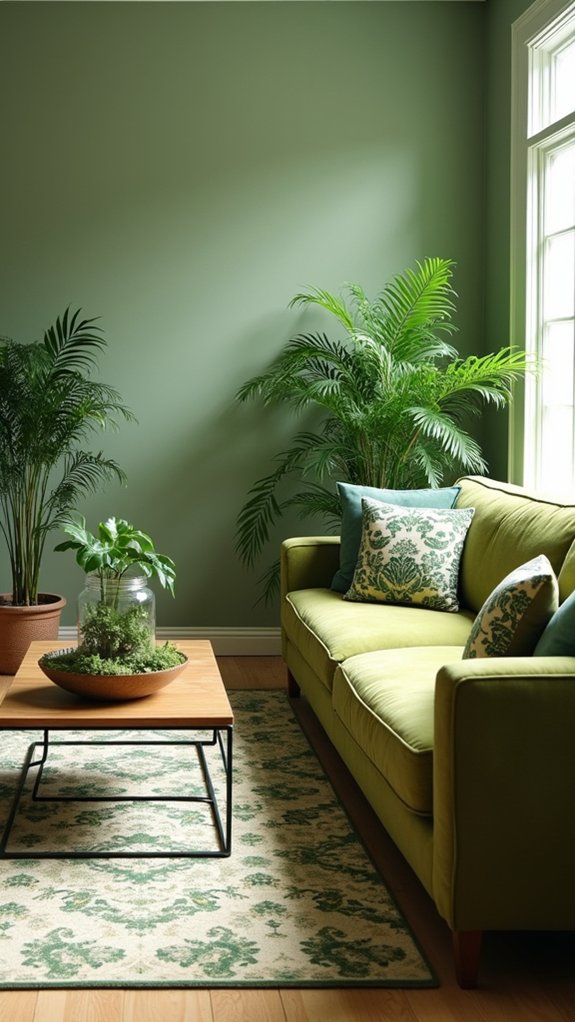
Combining green with patterned decor introduces layered visual complexity and accentuates the architectural features of a living room.
Contrasting bold prints—such as geometric or botanical motifs—against green walls or upholstery can define zones and amplify spatial depth in compact layouts.
Strategic placement of patterned accessories guarantees the interplay between color and design remains balanced and cohesive.
Layer Patterns and Green
Pattern layering transforms a green living room into a visually engaging space by introducing dynamic contrasts and depth. Expertly layering different patterns with bold green tones results in a vibrant and dynamic atmosphere, perfect for both maximalist and eclectic interiors.
By balancing intricate motifs with deep greens, designers can delineate zones within compact spaces and infuse personality without visual clutter. Accessories featuring patterns—like cushions or throws—offer flexibility and can easily update the room’s look as trends evolve.
The following strategies highlight effective approaches:
- Combine botanical prints with geometric patterns for visual intrigue.
- Use patterned rugs to anchor seating areas against bold green walls.
- Introduce striped or chevron textiles for movement and rhythm.
- Select accent chairs in patterned fabrics to punctuate green palettes.
- Layer patterned accessories to unify disparate elements harmoniously.
Contrast Bold Prints
Building on the visual complexity achieved through layered patterns, juxtaposing bold prints with green elements sharpens the room’s character and delineates focal points.
Strategic use of green in conjunction with patterned decor—such as vivid cushions, graphic curtains, or geometric area rugs—creates a dynamic yet cohesive environment.
Patterned wallpapers featuring green motifs introduce depth and visual intrigue, especially when paired with solid green furniture, ensuring a harmonious interplay rather than visual chaos.
The integration of accessories like patterned throws or accent pillows further reinforces the color story while providing tactile variation.
Embracing a maximalist approach, combining vibrant green hues with expressive patterns, cultivates a playful yet refined atmosphere.
This technique transforms the living room into an inviting, stylish retreat that celebrates both color and pattern.
Play With Ceiling Paint Techniques
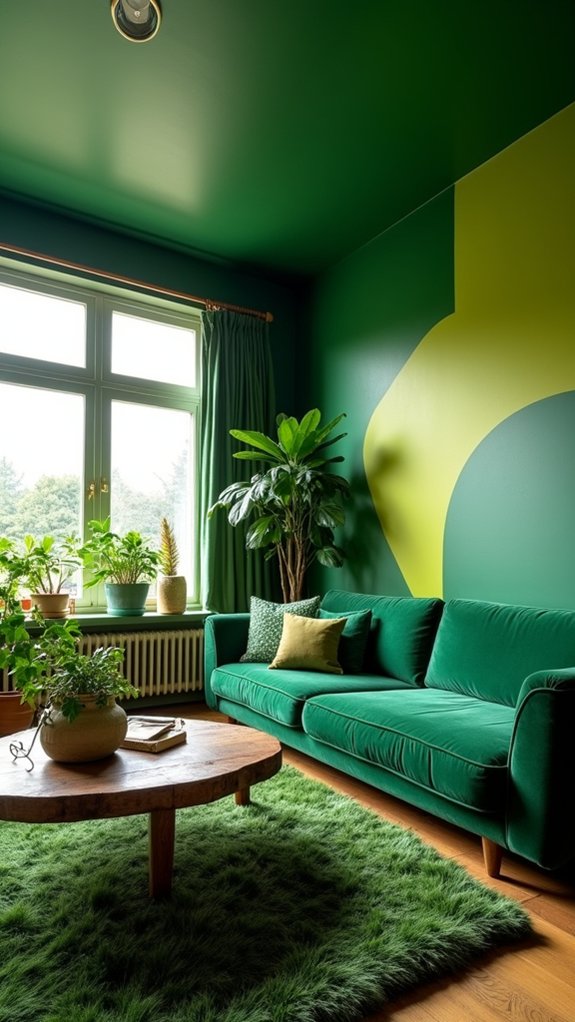
Enhance the visual impact of a green living room by incorporating strategic ceiling paint techniques that influence both spatial perception and ambiance.
Selecting the appropriate ceiling colour—be it dark or light—transforms the feel of the space. Dark colours on the ceiling create intimacy, visually lowering the height and making expansive rooms feel cozier. Conversely, light ceilings reflect natural light, maximizing airiness and promoting a sense of openness—especially effective in compact settings.
Experimenting with innovative paint techniques, such as ombre or two-tone gradients, introduces subtle dimension and visual intrigue that complements green decor.
- Apply dark colours overhead for a snug, enveloping effect
- Use light hues to amplify brightness and perceived space
- Integrate ombre paint techniques for soft shifts
- Try two-tone effects to add architectural interest
- Reflect natural light with lighter ceiling finishes
Use Green to Define Compact Spaces
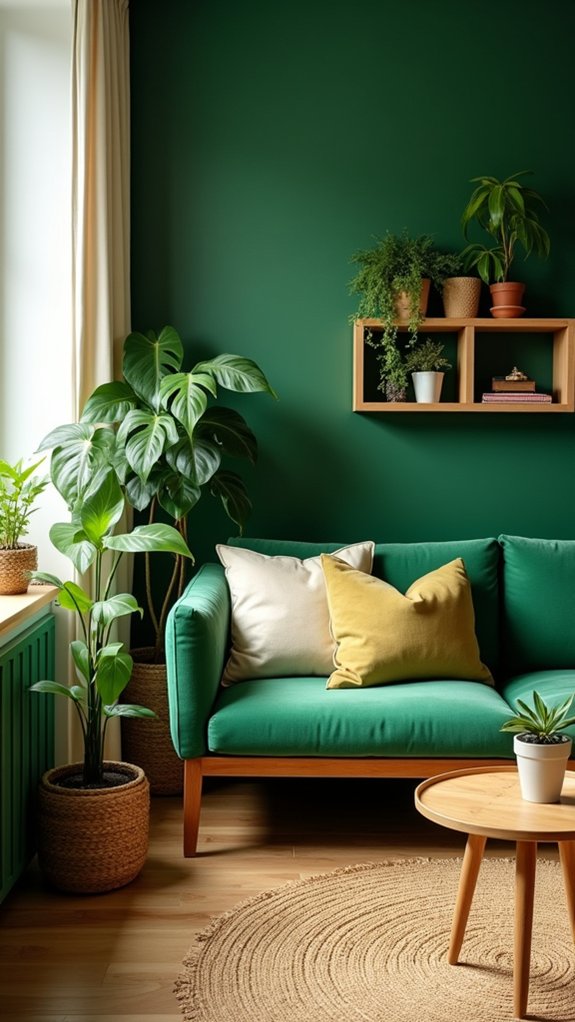
While ceiling paint techniques influence the overall ambiance of a green living room, thoughtful application of green tones can also delineate and optimize compact spaces. Employing bold green accents—such as a vibrant sofa or striking wall art—creates focal points that anchor the room without overpowering limited square footage. Lighter shades like sage or mint on walls foster a fresh, expansive visual effect, ideal for making compact spaces feel open and inviting. Layering textures in green, through knitted throws or woven baskets, adds warmth and tactile interest. To further enhance character, green-patterned cushions and textiles unify the scheme. Strategic placement of plants introduces natural greenery, promoting calmness and amplifying perceived space.
| Green Element | Compact Space Benefit |
|---|---|
| Sage wall paint | Airy, expansive feel |
| Green sofa | Focal point, defined area |
| Textured throws | Inviting, layered depth |
Opt for Retro-Inspired Green and Brown Schemes
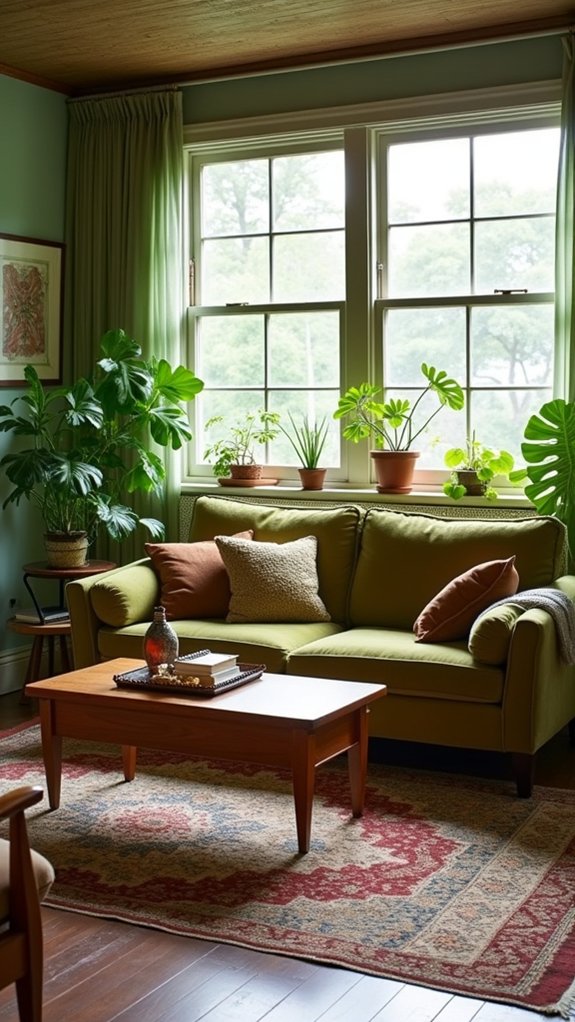
A retro-inspired approach harnesses the harmonious interplay of olive or forest green with warm brown tones, channeling an authentic 70s color palette.
Designers recommend layering tactile elements—such as rattan, walnut, or corduroy—with vintage-inspired patterns to create visual interest and depth.
Strategic use of bold prints and textured finishes guarantees the scheme feels both nostalgic and contemporary, ideal for homeowners seeking a distinctive yet inviting space.
Embrace 70s Color Palette
Drawing inspiration from the iconic 1970s, a retro-inspired green and brown color palette establishes a foundation of warmth and nostalgia in the living room. Expertly curated, this scheme utilizes olive green hues paired with rich brown for a sophisticated, earthy tone that embodies the retro aesthetic.
Strategic use of color blocking and accent integration creates a space that feels both inviting and visually balanced. Terracotta accents add depth, complementing the green and brown while enhancing the vintage motif.
For a cohesive, era-specific atmosphere, consider these practical design elements:
- Olive green walls or upholstery for a foundational retro vibe
- Dark wooden furniture to underscore warmth and authenticity
- Terracotta ceramics or planters for color contrast
- Earthy tones in decorative accessories
- Subtle retro-inspired lighting fixtures to complete the look
Layer Textures and Patterns
Building upon the foundation of retro-inspired green and brown hues, layering textures and patterns introduces dimension and tactile appeal to the living room.
Expert designers recommend layering different textures—plush rugs, knitted throws, and velvet cushions—to amplify depth while maintaining a unified palette. Green undertones in textiles or wall coverings harmonize with warm brown furnishings, such as rattan or walnut, reinforcing a connection to nature.
Incorporate patterned elements, like geometric cushions or botanical prints, to create visual intrigue and break up expanses of solid color. Accessorizing with vintage-inspired decor—terracotta pots or retro art—contributes to adding personality, making the space both fresh and timeless.
Strategic juxtaposition of materials and motifs guarantees a balanced, inviting ambiance that celebrates retro character with contemporary relevance.
Let Natural Light Enhance Green Features
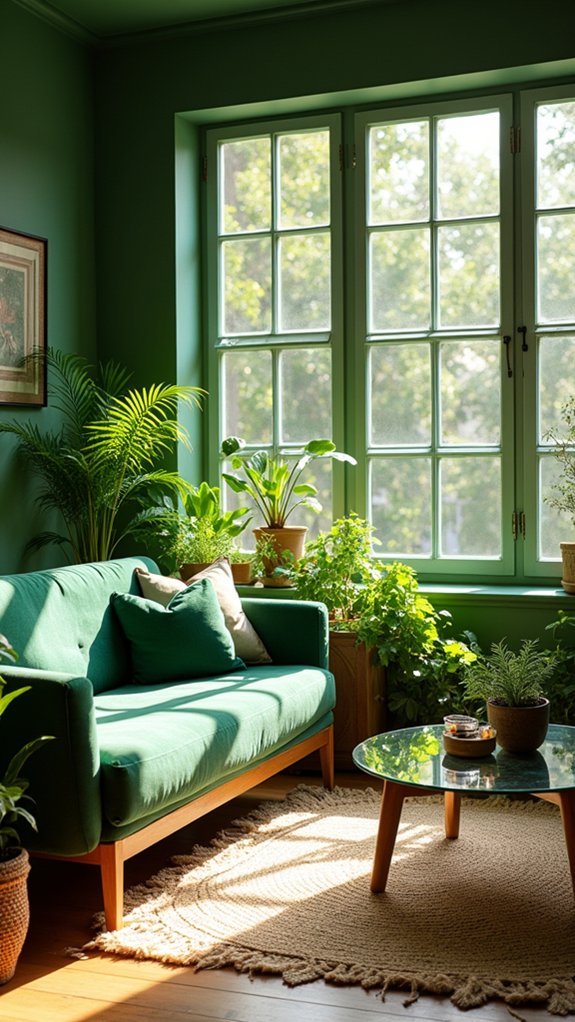
Maximizing natural light transforms a green living room, intensifying the depth and vibrancy of green hues while fostering a lively, inviting atmosphere.
Expertly curated green features benefit from strategic daylight management, which amplifies their visual impact and integrates the room with its natural surroundings. Harnessing natural light not only brightens the space but also accentuates the rich spectrum of greens, producing a dynamic interplay between light and color.
- Install expansive windows or glass doors to blur boundaries between the green room and outdoor scenery.
- Opt for sheer window treatments to diffuse sunlight and maintain privacy without diminishing luminosity.
- Position mirrors to reflect natural light, visually enlarging the space and accentuating green decor.
- Select light-hued furnishings to balance bold green features.
- Embrace open layouts to facilitate ideal light flow throughout the green room.
Frequently Asked Questions
What Colors Go With Green in a Living Room?
When selecting green color combinations for a living room, experts suggest accent colors such as black, white, mustard yellow, or fuchsia. Thoughtful fabric choices in soft neutrals or vivid hues enhance visual contrast and create dynamic, balanced spaces.
How Can I Make My Living Room More Inviting?
To make a living room more inviting, designers recommend layering cozy textiles like throws and cushions, implementing warm lighting schemes, and arranging inviting layouts that facilitate conversation, while integrating tactile materials and soft color palettes for enhanced comfort.
What Color of Sofa Goes With Green Walls?
Selecting a sofa for green walls involves considering sofa materials like linen or velvet, incorporating accent colors such as beige or navy, and utilizing pattern ideas—florals, geometrics—to create visual interest while maintaining harmony and sophistication within the space.
What Shade of Green Makes a Room Look Bigger?
For maximizing perceived space, light green shades like mint or sage offer ideal reflectivity and visual expansion. Unlike dark green, which absorbs light, light green enhances openness, especially when paired with green accents and neutral furnishings for balanced aesthetics.
Conclusion
Incorporating green into living room design offers a dynamic interplay between tranquility and vibrancy. Through thoughtful application—whether via verdant feature walls, tactile green velvet upholstery, or botanical accents—spaces gain both aesthetic depth and biophilic appeal. Strategic pairing with neutrals, black, or retro elements further refines the palette. Harnessing natural light amplifies these effects, ensuring each room feels fresh and inviting. Designers can leverage these expert strategies to create visually cohesive, practical, and welcoming living environments.
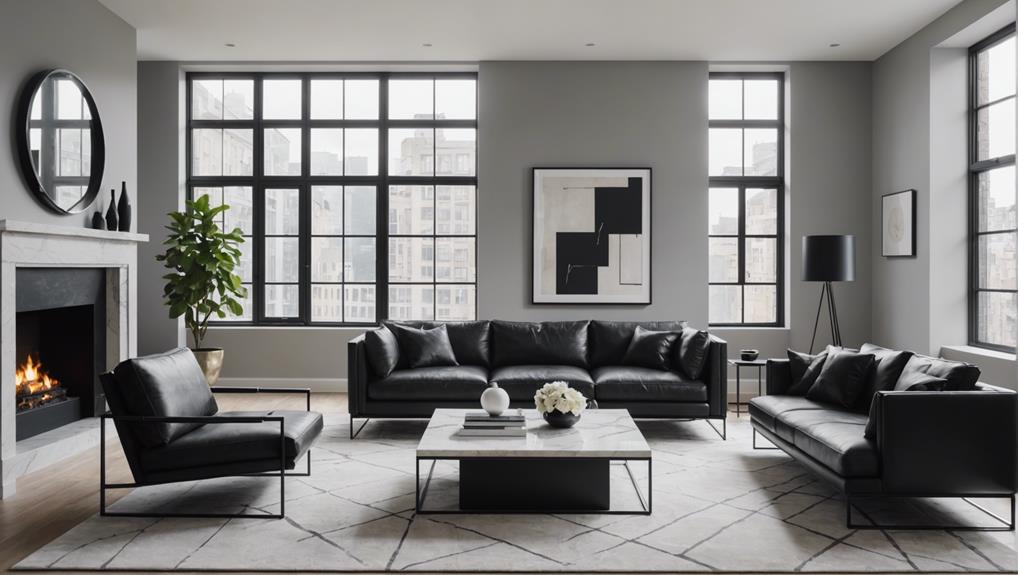
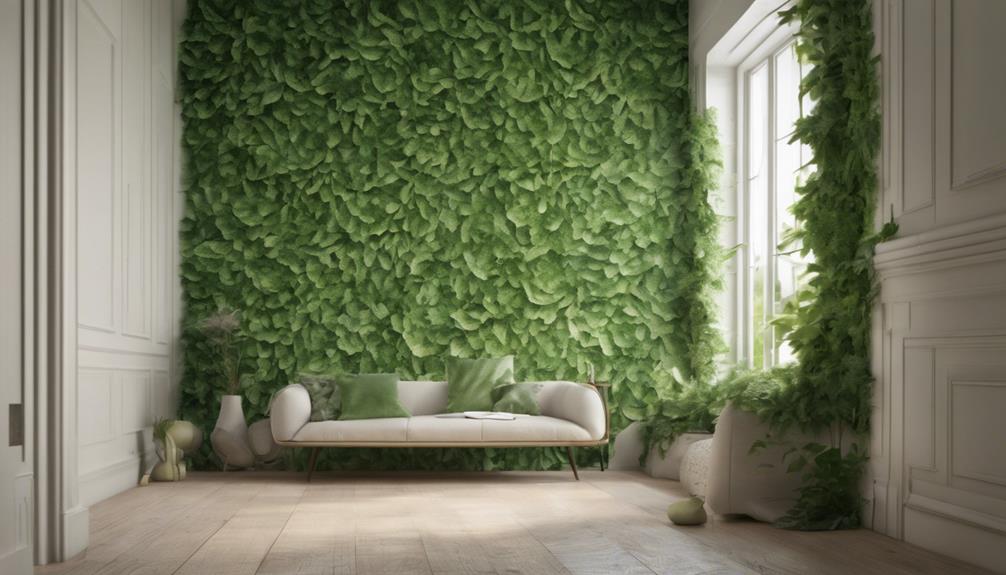
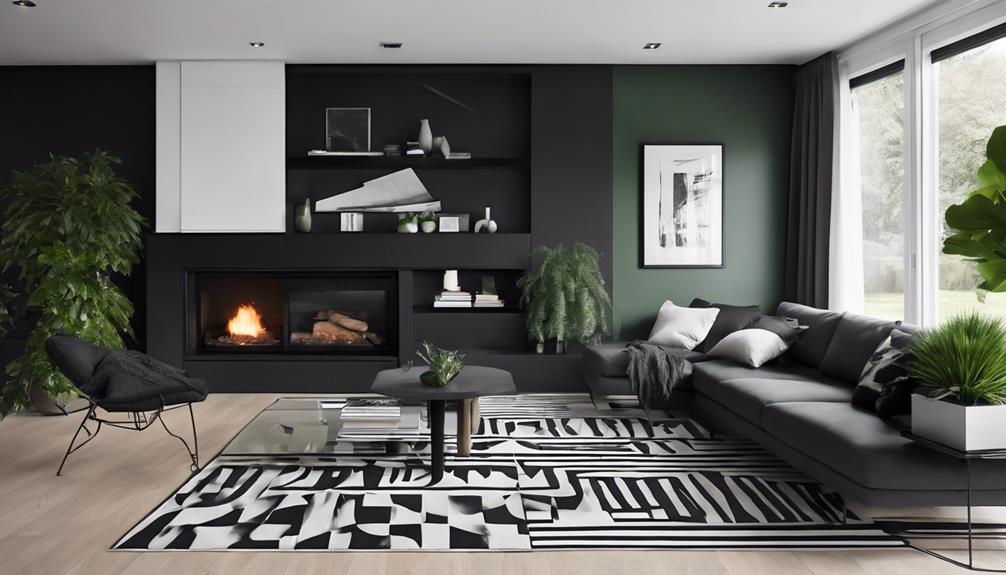
Leave a Reply